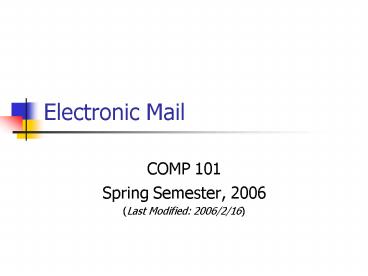Electronic Mail - PowerPoint PPT Presentation
1 / 32
Title: Electronic Mail
1
Electronic Mail
- COMP 101
- Spring Semester, 2006
- (Last Modified 2006/2/16)
2
A popular (killer) application
- Allows fast and accurate communications between
people at low or no cost. - Handles text, graphics, voice, video, programs,
etc. - Supports various levels of confidentiality.
3
Popular mail tools
- Microsoft Outlook/Outlook Express
- Netscape Messenger
- pine (Unix-based)
- Various webmail services
4
Basic elements of an e-mail system
- Each user must have a unique mail address (e.g.,
shen_at_cs.ust.hk). - The address is registered with a mail server at
the users organization or at an Internet service
provider. - The mail tool retrieves incoming messages from
the server upon launch and at regular intervals. - The mail tool sends new messages to the server as
instructed by the user.
5
Elements of a mail message
- To Vincent Shen
- Subject COMP 101 lectures
- From The Boss
- Date 20 Feb 2006 095023
- The From and Date lines and other header
lines are supplied by the system (but could be
faked).
6
Contents of a mail message
- Mostly English text
- Chinese characters might not be received properly
due to confusion between different encoding
systems - Chinese document is best sent through a MIME
(Multi-purpose Internet Mail Extension)
attachment
7
Protocols used by the mail tool
- SMTP Simple Mail Transfer Protocol sending mail
to the server - POP Post Office Protocol retrieving mail from
the server with option to leave the messages
there for designated period - IMAP Internet Message Access Protocol
retrieving mail from the server but leaving the
messages there indefinitely
8
Netiquette
- Salute the recipient properly e.g.,
- Dear Professor Shen,
- Describe the attachment, if any e.g.,
- Attached is the draft announcement in Chinese
for your comments. - Ending the message properly e.g.,
- With best regards,
- -Vincent
9
Netiquette
- Using shorthand convention to express emotion
e.g., - emphasis
- LOUD VOICE
- -) for humor
- -( for sadness
- Using e-mail for information, not for debate
10
(Lack of) privacy on e-mails
- An IP packet is different from a mail envelope
there is no trace for tampering. - There may be many hops (servers and routers)
between mail sender and recipient. - The server or each hop site may copy the IP
packets for audit, back-up, performance analysis,
etc.
11
Mail encryption
- Privacy and confidentiality
- Shared private key
- Public-key infrastructure (PKI)
- Strength of encryption
12
Public-key encryption
- Feature is supported by many popular mail tools
e.g., Outlook Express. - Encrypted messages can be cracked only by most
determined interlopers using most powerful
computers or by stolen private key. - Digital signatures are legally recognized in Hong
Kong.
13
Summary
14
Using PKI at HKUST
- Use the digital certificate (e-Cert) in your
student ID or get one from the HKUST Certificate
Authority (CA https//keon.ust.hk ). - Exchange the public keys with your correspondents
by sending them a digitally signed message and
requesting a signed message in return. - Safeguard your private key since you cannot read
the archived encrypted messages if the private
key is lost.
15
Issues that stress the e-mail
- Scam
- Hoax
- Spam
- Phishing
- Spoofing
- Virus
16
Sites that provide virus/hoax information
- http//www.trendmicro.com.cn
- http//www.sophos.com
- http//www.symantec.com
17
(No Transcript)
18
Private key encryption
- Plain text
- CATS HAVE FUR
- Encrypted by Key 1 shift character by 1
- DBUT IBWF GVS
- Encrypted by Key 2 shift character by 2
- ECVU JCXG HWT
- Data Encryption Standard (DES)
19
Public-key infrastructure
- An ingenious method invented by Rivest, Shamir,
and Adleman (RSA). - A certificate authority (CA) generates a pair of
keys for a user. - A message encrypted by one of the keys can only
be decrypted using the other in the key-pair. - Encryption/decryption method is supported by many
mail tools.
20
Creating encrypted message
21
Message body to others
22
Message to intended recipient
23
E-mail scams
- Messages that offer large sums of money (e.g.,
the Nigerian scam) - Chain letters
24
E-mail hoaxes
- Messages that ask recipients to delete system
programs - Messages that defame people/organizations
25
E-mail spams
- Normally sent with fake sender address
- Unsolicited messages that promote merchandise or
activities
26
E-mail phishing
- Fake messages that request confidential
information (e.g., bank fraud)
27
E-mail spoofing
- Domain names that are different but appear
similar to well-known names e.g., - AUDIT_at_H0NGK0NGBANK.COM
- accounts_at_paypa1.com
- More serious problem when international domain
names (IDN) are introduced
28
E-mail viruses
- Normally come as a program in a mail attachment
- May cause havoc if opened (launched) accidentally
- May replicate by being sent to the victims
correspondents
29
To resist virus attacks
- Keep virus protection software up-to-date
- Open/launch mail attachments only if
- It came from a familiar person
- It addresses you in person i.e., Dear Vincent
instead of Dear shen - It is signed in the persons usual way i.e.,
-Vincent
30
(No Transcript)
31
(No Transcript)
32
(No Transcript)































